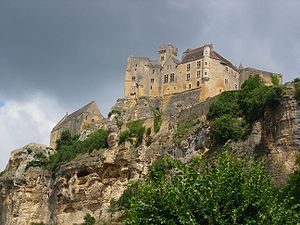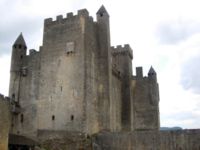
Château de Beynac
Encyclopedia

Castle
A castle is a type of fortified structure built in Europe and the Middle East during the Middle Ages by European nobility. Scholars debate the scope of the word castle, but usually consider it to be the private fortified residence of a lord or noble...
situated in the commune
Communes of France
The commune is the lowest level of administrative division in the French Republic. French communes are roughly equivalent to incorporated municipalities or villages in the United States or Gemeinden in Germany...
of Beynac-et-Cazenac
Beynac-et-Cazenac
Beynac-et-Cazenac is a commune in the Dordogne department in southwestern France.The medieval Château de Beynac is located in the commune.The village is classified as one of Les plus beaux villages de France ....
, in the Dordogne
Dordogne
Dordogne is a départment in south-west France. The départment is located in the region of Aquitaine, between the Loire valley and the High Pyrénées named after the great river Dordogne that runs through it...
département of France. The castle is one of the best-preserved and best-known in the region.
This Middle Ages
Middle Ages
The Middle Ages is a periodization of European history from the 5th century to the 15th century. The Middle Ages follows the fall of the Western Roman Empire in 476 and precedes the Early Modern Era. It is the middle period of a three-period division of Western history: Classic, Medieval and Modern...
construction, with its austere appearance, is perched on top of a limestone
Limestone
Limestone is a sedimentary rock composed largely of the minerals calcite and aragonite, which are different crystal forms of calcium carbonate . Many limestones are composed from skeletal fragments of marine organisms such as coral or foraminifera....
cliff, dominating the town and the north bank of the Dordogne River
Dordogne River
The Dordogne is a river in south-central and southwest France.-Name:Contrary to appearances, the name of the Dordogne is not a recent word resulting from the names of the Dore and the Dogne...
.
History
The castle was built from the 12th century by the barons of Beynac (one of the four baronies of PérigordPérigord
The Périgord is a former province of France, which corresponds roughly to the current Dordogne département, now forming the northern part of the Aquitaine région. It is divided into four regions, the Périgord Noir , the Périgord Blanc , the Périgord Vert and the Périgord Pourpre...
) to close the valley. The sheer cliff face being sufficient to discourage any assault from that side, the defences were built up on the plateau: double crenellated walls, double moats, one of which was a deepened natural ravine, double barbican
Barbican
A barbican, from medieval Latin barbecana, signifying the "outer fortification of a city or castle," with cognates in the Romance languages A barbican, from medieval Latin barbecana, signifying the "outer fortification of a city or castle," with cognates in the Romance languages A barbican, from...
.

Romanesque architecture
Romanesque architecture is an architectural style of Medieval Europe characterised by semi-circular arches. There is no consensus for the beginning date of the Romanesque architecture, with proposals ranging from the 6th to the 10th century. It developed in the 12th century into the Gothic style,...
keep
Keep
A keep is a type of fortified tower built within castles during the Middle Ages by European nobility. Scholars have debated the scope of the word keep, but usually consider it to refer to large towers in castles that were fortified residences, used as a refuge of last resort should the rest of the...
with vertical sides and few openings, held together with attached watch towers and equipped with a narrow spiral staircase terminating on a crenellated terrace. To one side, a residence of the same period is attached; it was remodelled and enlarged in the 16th and 17th centuries. On the other side is a partly 14th century residence side-by-side with a courtyard and a square plan staircase serving the 17th century apartments. The apartments have kept their woodwork and a painted ceiling from the 17th century. The Salle des États (States' Hall) has a Renaissance sculptured fireplace and leads into a small oratory
Oratory (worship)
An oratory is a Christian room for prayer, from the Latin orare, to pray.-Catholic church:In the Roman Catholic Church, an oratory is a structure other than a parish church, set aside by ecclesiastical authority for prayer and the celebration of Mass...
entirely covered with 15th century fresco
Fresco
Fresco is any of several related mural painting types, executed on plaster on walls or ceilings. The word fresco comes from the Greek word affresca which derives from the Latin word for "fresh". Frescoes first developed in the ancient world and continued to be popular through the Renaissance...
es, included a Pietà
Pietà
The Pietà is a subject in Christian art depicting the Virgin Mary cradling the dead body of Jesus, most often found in sculpture. As such, it is a particular form of the Lamentation of Christ, a scene from the Passion of Christ found in cycles of the Life of Christ...
, a Saint Christopher, and a Last Supper
Last Supper
The Last Supper is the final meal that, according to Christian belief, Jesus shared with his Twelve Apostles in Jerusalem before his crucifixion. The Last Supper provides the scriptural basis for the Eucharist, also known as "communion" or "the Lord's Supper".The First Epistle to the Corinthians is...
in which Saint Martial
Saint Martial
Saint Martial was the first bishop of Limoges in today's France, according to a lost vita of Saturnin, first bishop of Toulouse, which Gregory of Tours quotes in his History of the Franks.-Life:...
(first bishop of Limoges) is the maître d'hôtel.
At the time of the Hundred Years' War, the fortress at Beynac was in French hands. The Dordogne was the border between France and England. Not far away, on the opposite bank of the river, the Château de Castelnaud
Château de Castelnaud-la-Chapelle
The Château de Castelnaud is a medieval fortress in the commune of Castelnaud-la-Chapelle, overlooking the Dordogne River in Périgord, southern France. It was erected to face its rival, the Château de Beynac.-History:...
was held by the English. The Dordogne region was the theatre of numerous struggles for influence, rivalries and occasionally battles between the English and French supporters. However, the castles fell more often through ruse and intrigue rather than by direct assault, because the armies needed to take these castles were extremely costly: only the richest nobles and kings could procure them.
The castle was bought in 1962 by Lucien Grosso who has restored it.
Visitors to the castle can see sumptuous tapestries showing hunting and other scenes from the lives of the lords of the period. The Château de Beynac has been listed as a monument historique
Monument historique
A monument historique is a National Heritage Site of France. It also refers to a state procedure in France by which national heritage protection is extended to a building or a specific part of a building, a collection of buildings, or gardens, bridges, and other structures, because of their...
by the French Ministry of Culture since 1944.
Beynac castle has served as a location for several films, including Les Visiteurs
Les Visiteurs
Les Visiteurs is a French film directed by Jean-Marie Poiré and released in 1993. In this comedy, a 12th-century knight and his servant travel in time to the end of the 20th century and find themselves adrift in modern society....
by Jean-Marie Poiré
Jean-Marie Poiré
Jean-Marie Poiré is a French film director, screenwriter, and producer. He is the son of the producer Alain Poiré.-Filmography as director:* Ma femme... s'appelle Maurice Jean-Marie Poiré (born July 10, 1945) is a French film director, screenwriter, and producer. He is the son of the producer...
, in 1993, La Fille de d'Artagnan by Bertrand Tavernier
Bertrand Tavernier
Bertrand Tavernier is a French director, screenwriter, actor, and producer.-Life and career:Tavernier was born in Lyon, the son of Geneviève and René Tavernier, a publicist and writer, several years president of the French PEN club. Tavernier wanted to become a filmmaker since the age of thirteen...
, in 1994, Ever After
Ever After
Ever After: A Cinderella Story is a 1998 film inspired by the fairy tale Cinderella, directed by Andy Tennant and starring Drew Barrymore, Anjelica Huston and Dougray Scott. The screenplay is written by Tennant, Susannah Grant, and Rick Parks. The original music score is composed by George Fenton...
by Andy Tennant
Andy Tennant
Andy Tennant is an American screenwriter, film and television director, and dancer.-Life and career:Born in Chicago, Illinois, Tennant was raised in Flossmoor, Illinois, a suburb of Chicago. His father was Don Tennant, a legendary creative advertising talent with Leo Burnett Agency in Chicago...
, in 1998, and Jeanne d'Arc
The Messenger: The Story of Joan of Arc
The Messenger: The Story of Joan of Arc is a French/American historical drama film directed by Luc Besson. The screenplay was written by Besson and Andrew Birkin, and the original music score was composed by Éric Serra....
by Luc Besson
Luc Besson
Luc Besson is a French film director, writer, and producer. He is the creator of EuropaCorp film company. He has been involved with over 50 films, spanning 26 years, as writer, director, and/or producer.-Early life:...
, in 1999. The village of Beynac below the chateau, also served as a location for the film Chocolat
Chocolat
Chocolat is a 1999 novel by Joanne Harris. It tells the story of Vianne Rocher, a young mother, who arrives at a fictional insular French village of Lansquenet-sous-Tannes with her six-year-old daughter, Anouk...
by
Lasse Hallström
Lasse Hallström
Lars Sven "Lasse" Hallström is a Swedish film director. He was nominated for an Academy Award for Best Director for My Life as a Dog and later for The Cider House Rules .-Life and career:...
, in 2000.
Barons de Beynac
- Maynard (1115-1124)
- Adhémar (1147-1189)
- Richard Cœur de Lion, king of EnglandEnglandEngland is a country that is part of the United Kingdom. It shares land borders with Scotland to the north and Wales to the west; the Irish Sea is to the north west, the Celtic Sea to the south west, with the North Sea to the east and the English Channel to the south separating it from continental...
(1189-1199) - Pons I (1200-1209)
- Gaillard (1238-1272)
- Pons II (1251-1300)
- Adhémar II (1269-1348)
- Pons III (-1346)
- Boson, known as Pons (1341-1348)
- Pons IV (1362-1366)
- Philippe (-1403)
- Pons V (1461-1463)
- Jean-Bertrand (-1485)
- Geoffroy I (-1530)
- François (-1537)
- Geoffroy II (-1546)
- Geoffroy III
- Guy I (1643-)
- Isaac
- Guy II
- Pierre
- Marie-Claude (1732-18??)
- Christophe-Marie (1764-18??)
- Louis, dit Ludovic (1784-18??)
- Christophe-Amable-Victoire (1831-18??)
- Soffrey-Paul-Louis-Armand (1857-19??)
- Amable-Avit-Christophe (1895-)
- Pierre-Aimé-Soffrey-Armand (1929-)

